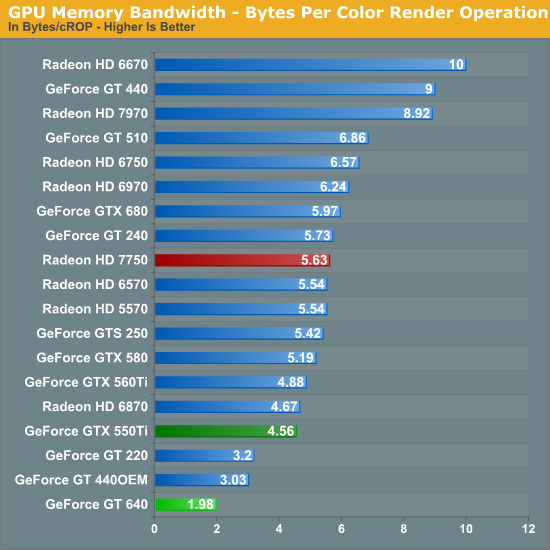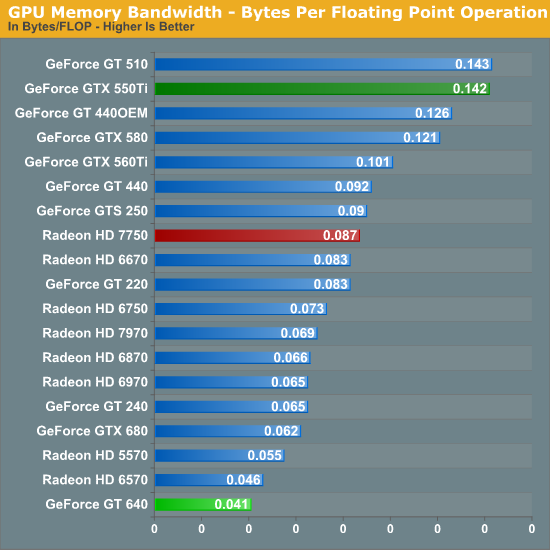Zotac GeForce GT 640 DDR3 Review: Glacial Gaming & Heavenly HTPC
by Ryan Smith & Ganesh T S on June 20, 2012 12:00 PM ESTMusing About Memory Bandwidth & The Test
As we discussed in our introduction, NVIDIA is launching the GeForce GT 640 exclusively as a DDR3 part. Because of the lack of memory bandwidth this is going to hold back the performance of the card, and while we don’t have a GDDR5 card at this time it will still be pretty easy to see what the performance impact is once we jump into our gaming performance section and compare it to other cards like the GTS 450.
In the meantime however we wanted to try to better visualize just how little memory bandwidth the DDR3 GT 640 had. It’s one thing to say that the card has 28GB/sec of memory bandwidth, but how does that compare to other cards? For the answer to that we drew up a couple of graphs based on the ratio of theoretical memory bandwidth to theoretical performance.

The first graph is the ratio of memory bandwidth to color pixel ROPs (bytes per color operation), which is an entirely synthetic metric but a great illustration of the importance of memory bandwidth. Render operations are the biggest consumer of memory bandwidth so this is where DDR3 cards typically choke.
Because of the nature of this graph cards are all over the place, with cards with particularly unusual configurations (such as the 4 ROP GT 440) appearing near the top. Still, high-end cards such as the GTX 680 and Radeon HD 7970 have among the highest ratio of memory bandwidth to color render operations, while lower-end cards generally have a lower ratio. At 1.97 B/cOP, the DDR3 GT 640 has the lowest ratio by far, and is only 66% of the ratio found on the next-lowest card, the GeForce GT 440 OEM. The fact of the matter is that because of its high clockspeed and 16 ROPs, the DDR3 GT 640 has by far the lowest ratio than any other card before it.

Our second graph is the ratio of memory bandwidth to shader operations (bytes per FLOP). Shaders aren’t nearly as bandwidth constrained as ROPs thanks to liberal use of register files and caches, but I wanted to take a look at more than just one ratio. Compared to our ROP chart the GT 640 isn’t nearly as much of an outlier, but it still has the lowest ratio of memory bandwidth per FLOP out of all of the cards in our charts.
Now to be clear not all of this is NVIDIA’s fault. Memory speeds have not kept pace with Moore’s Law, so GPU performance has been growing faster than memory speeds for quite some time leading to a general downwards trend. But the GT 640 is a special card in this respect in that there has never been a card this starved for memory bandwidth. This is further impacted by the fact that while GDDR5 speeds have at least been increasing as a modest rate over the years as GPU memory controllers and memory chip production have improved, DDR3 memory speeds have been locked in the 1.6GHz-1.8GHz range for years. Simply put, the gap between GDDR5 and DDR3 has never been greater. Even a conservative memory clock of 4.5GHz would give a GDDR5 card 2.5 times the memory bandwidth of a typical DDR3 card.
Of course there’s still a place in the world for DDR3 cards, particularly in very low power situations, but that place is shrinking in size every day. If and when it arrives, we expect that the GDDR5 GT 640 will quickly trounce the DDR3 version in virtually all gaming scenarios. DDR3 for a card this power hungry (relatively speaking) and with this many ROPs just doesn’t look like it makes a lot of sense.
The Test
For our test we’re using the latest NVIDIA drivers at the time our benchmarks were taken (301.42), and for AMD’s cards we’re using the new Catalyst 12.6 betas. For analysis purposes we’ve thrown in a couple of additional cards that we don’t normally test, such as the GDDR5 GeForce GT 240. The GDDR5 GT 240 has 43.5GB/sec of memory bandwidth but with a far older and less powerful GPU, which makes for an interesting comparison on progress.
| CPU: | Intel Core i7-3960X @ 4.3GHz |
| Motherboard: | EVGA X79 SLI |
| Chipset Drivers: | Intel 9.2.3.1022 |
| Power Supply: | Antec True Power Quattro 1200 |
| Hard Disk: | Samsung 470 (256GB) |
| Memory: | G.Skill Ripjaws DDR3-1867 4 x 4GB (8-10-9-26) |
| Case: | Thermaltake Spedo Advance |
| Video Cards: |
AMD Radeon HD 7770 AMD Radeon HD 7750-800 AMD Radeon HD 6670 AMD Radeon HD 5750 NVIDIA GeForce GT 640 DDR3 NVIDIA GeForce GTX 550 Ti NVIDIA GeForce GTS 450 NVIDIA GeForce GT 440 NVIDIA GeForce GT 240 |
| Video Drivers: |
NVIDIA ForceWare 301.42 AMD Catalyst 12.6 Beta |
| OS: | Windows 7 Ultimate 64-bit |










60 Comments
View All Comments
saturn85 - Thursday, June 21, 2012 - link
great folding@home benchmark.kallogan - Thursday, June 21, 2012 - link
WORST GPU EVERdertechie - Friday, June 22, 2012 - link
Here's hoping DDR4 is cheap and cheery enough for low end cards when it comes out, because this is ridiculous. We have here a card with 50% more shader horsepower than an 8800 Ultra, and 70% less memory bandwidth. Way to ruin a perfectly good GPU by not shipping with real memory.My old 7900 GS had more memory bandwidth than this. . . in 2006.
skgiven - Saturday, June 23, 2012 - link
At GPUGRID the CUDA4.2 crunching performance of the GT 640 matches that of a GTX460.65W TDP vs 150W TDP.
The low running cost, no high end PSU, or 6-pin power cable requirements make it a good entry card for crunchers.
The 950MHz GDDR5 version (75W TDP) and the 797MHz DDR3 (50W) TDP versions should also perform well.
anac6767 - Thursday, June 28, 2012 - link
A video card with a fan on it has no place in a modern HTPC... we're well past that. You might as well order a full tower (80's off white) ATX case and corded peripherals to go along with your noisy card.infoilrator - Wednesday, July 4, 2012 - link
Not appealing at this price.FWIW department, mITX motherboards taking single slot cards are maybe due for an upgrade.
Maybe a motherboard could mount connectors sideways to allow fitting a two slot card.
Maybe mITX cases could come with provision for two slot cards.
If the numbers are right AMD Llano/Trinity and Intel IVB HD4000 make more sense than adding a $100 discrete card with limited capabilities. At least at the moment.
I am seeing AMD Llano 3850/ A75 Combinations for $150 in mATX. Better, even though I find FM1 limiting.
Contemplating an FM1 or FM2 such a build in a couple months. Unless I go after more GPU power.
? still new at these decisions.
Felip3 - Saturday, July 7, 2012 - link
Look what I found ...http://www.gainward.com/main/vgapro.php?id=886&...
xeizo - Friday, July 27, 2012 - link
That's old Fermi and not new Kepler, rather uninteresting even though it sure is gddr5, a passive GT640 with gddr5 would be interesting but seems nonexistent. Too bad!stanislav_kosev - Thursday, September 20, 2012 - link
I love me some painfully slow gaming! http://www.insightvision.biz/cd-dvd-packagingMontmac - Friday, March 1, 2013 - link
Don't expect Zotac to admit this when you call them to try and get a replacement card. One of the high ups told me they had never heard of this problem.However another in tech support told me he had and will be sending me a call tag to get the card I just bought replaced.
It has taken almost 4 weeks to get this accomplished. I'm not very impressed with Zotac at all.
When a company manufactures something wrong it shouldn't be a problem getting an exchange but it's not the case with them.